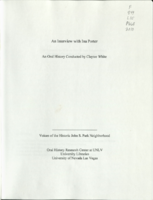Search the Special Collections and Archives Portal
Search Results
Employees - personal injury, 1925-1954
Level of Description
Archival Collection
Collection Name: Union Pacific Railroad Collection
Box/Folder: Box 150 (Restrictions apply)
Archival Component
Taxes - federal income, 1916-1950
Level of Description
Archival Collection
Collection Name: Union Pacific Railroad Collection
Box/Folder: Box 150 (Restrictions apply)
Archival Component

Transcript of interview with Ina Porter by Claytee White, January 5, 2010
Date
Archival Collection
Description
Ina Porter recalls the story of choosing to move to the John S. Park Neighborhood in the 1940s. She and her husband Burdell were accustom to paying cash for everything and needed to establish credit with Sears to purchase their $5000 home, which was not considered inexpensive. They were among the earlier homeowners and soon the neighborhood grew to include a Mormon Church that would become so integral to the Porter family's life and to the John S. Park community. Ina was born 1917 in the small southern Utah town of Kanab. She describes her youth and speaks of the Great Depression. Ina graduated from high school in 1935, married in 1936 and moved to Las Vegas, where there were jobs for her husband. Finding work after his graduation from college was not easy, but because he had been a bus driver he was able to secure a position driving a bus for the Union Pacific Railroad and later Greyhound Bus Line. Years later Ina, Burdell and their family were part of the fiber of the Joh
Text

Transcript of interview with Robert Kesterson by James M. Greene, October 24, 1974
Date
Archival Collection
Description
On October 24, 1974, collector James M. Greene interviewed civil engineer, Robert Kesterson (born on August 12th, 1920 in Key West, Florida) in his home in Henderson, Nevada. Mrs. Kesterson is also present during the interview. This interview offers an overview on life in Boulder City, Las Vegas, and Henderson, Nevada. The interview ends with a discussion on land development.
Text

Howard Heckethorn interview, February 15, 1979: transcript
Date
Archival Collection
Description
On February 15, 1979, collector Richard Eitland interviewed Howard Heckethorn (born September 14th, 1922 in St. George, Utah) at Red Rock Elementary School in Las Vegas, Nevada. Mr. Heckethorn discusses going to school in the early days of Las Vegas, Nevada. He also talks about many notable teachers he had, as well as the development of the Las Vegas area.
Text

Transcript of interview with Elbert Edwards by Ronald Johns, 1972
Date
Archival Collection
Description
On an unspecified date in 1972, Ronald Johns interviewed Elbert Edwards (born 1907 in Panaca, Nevada) about his life in Southern Nevada. Edwards first talks about his family’s move to Panaca, Nevada in 1864 and talks briefly about his work in Las Vegas public schools during the Great Depression. The two also discuss the Boulder Dam, Edwards’ involvement in politics, and mining in Nevada. He also talks about the cost to build a home in Las Vegas in 1936, the development of Boulder City, and the way of life in the small town of Panaca. The interview then moves on to the topics of the early territorial boundaries of Nevada and Utah, the atomic testing at the Nevada Test Site, and early water sources in Southern Nevada.
Text

Transcript of interview with Ed Fleming by Mark Lucas, February 8, 1977
Date
Archival Collection
Description
On February 8, 1977, Mark Lucas interviewed Edmund “Ed” Fleming (born 1915 in Virginia, Minnesota) about his experience in Southern Nevada. Fleming first talks about his moves to and from Nevada before describing the mining practices within the small towns in Southern Nevada. He also talks about his experience as a teacher in Pahrump and Goodsprings and his eventual move to Las Vegas, where he continued in the educational field. Fleming also talks about religion, transportation, funding for education, inflation, and cultural arts as they all relate to Las Vegas.
Text
Marie Heher oral history interview
Identifier
Abstract
Oral history interview with Marie Heher conducted by her daughter Sharon Heher on March 01, 1977 for the Ralph Roske Oral History Project on Early Las Vegas. In the interview, Heher discusses her early life in Boulder City, Nevada and Henderson, Nevada, as well as her education in Reno, Nevada and Las Vegas, Nevada. Heher also discusses the Helldorado parades and her experiences with the Union Pacific Train Depot in downtown Las Vegas, Nevada.
Archival Collection

Photograph of a horse drawn stagecoach, Tonopah (Nev.), circa 1905
Date
Archival Collection
Description
Image
Ryan, George Kelly, 1911-1977
George Kelly Ryan was a geological engineer, prospector, and land use advisor who lived in Las Vegas, Nevada from 1959 until his death. He served in the Marines during World War II and was a member of the Disabled American Veterans. George was also active in the Nevada Mining Council and the First United Methodist Church. George was born June 3, 1911 in Salt Lake City, Utah. His father was Archer De Vol "Archie" Ryan and his mother was Maggie Kelly.
Person
